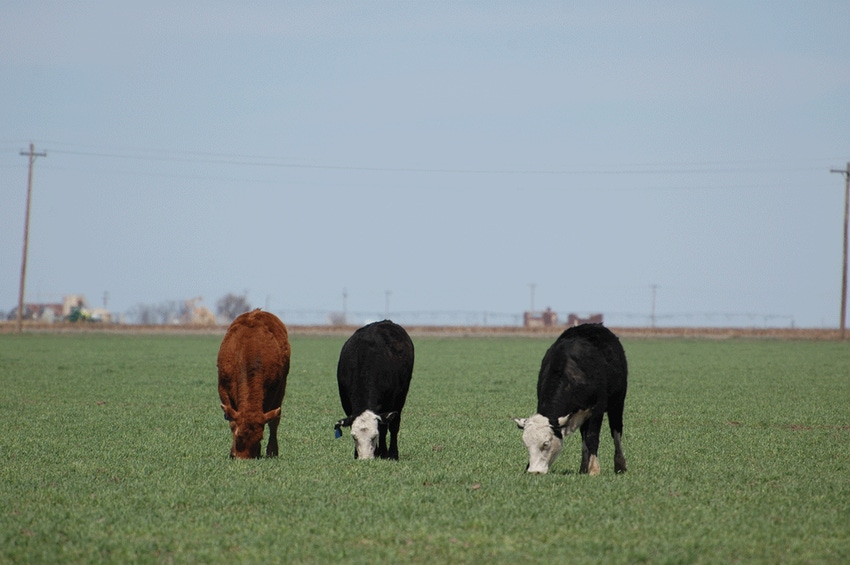Leveraging the power of (metabolizable) protein
Metabolizable protein helps cattle absorb essential nutrients.
September 15, 2016

Crude protein (CP) has long been a key number in measuring the value of forage and supplemental feed. But for stockers hitting wheat pasture or grass this fall, the amount of “metabolizable protein” (MP) may be more telling in ensuring that cattle take full advantage of amino acid nutrition in their diet.
Kip Karges, nutritionist and director of technical services at H.J. Baker Animal Health & Nutrition, says an MP program can help increase the amount of amino acids absorbed into an animal’s digestive system. “Using MP will account for the different types of protein that can be used by the animal for production purposes,” Karges says. “MP will allow nutritionists and producers to focus on amino acid [AA] nutrition, which, at the end of the day, is what an animal really requires.”
Karges says poultry producers have been balancing diets based on digestible AA for years, allowing them to be extremely efficient in their production systems. “Likewise, dairy producers also switched to MP instead of CP to increase milk production and components, which has allowed them to balance the amino acids in dairy diets,” he adds.
He notes that the CP system has been around forever, “and it’s just that, a crude measurement of the nutritional protein content of any feedstuff. That’s how many nutritionists and producers still measure and balance diets, even though the Beef Nutrient Research Council made the move to the MP system in 2000."
“I challenge producers and feeders to consider the MP system in their production programs. It is tough to get to a point where you can balance for lysine and methionine without first adapting to the MP system.”
Stocking rate, forage quality
David Lalman, Oklahoma State University Extension beef cattle specialist, says feed supplementation needs depend on forage quality and stocking rate. “We looked at two stocker programs that work well in the Southern Plains,” he says. “One is to boost performance with no change in stocking rate. The second program is a higher feeding rate to replace wheat pasture, or to increase the stocking rate on a pasture.”
In the first program, developed as Oklahoma Green Gold about 15 years ago, the supplement is highlighted by about 62% ground sorghum or corn, 21% wheat midds, 5% molasses, 4% limestone, 4% magnesium and 2.5% phosphate; and trace amounts of salt, vitamin A and vitamin-trace mineral mix; and an ionophore.
“With the program, the average pound of supplement per pound of added weight gain has been about 4.7 to 1,” Lalman says. “With an estimated supplement cost of around $160 per ton this year, give or take $25 per ton, the cost per pound of added gain should be somewhere around 38 cents per pound. Additional costs would include the labor, fuel and storage required to deliver the feed.”
 He says the second program is tailored for an increase in stocking rate. “In this program, an energy concentrate is fed at a rate of 0.75% to 1% of body weight on a daily basis,” Lalman says. “With this higher feeding rate, stocking rate can be increased by about 33%. Feed conversion in this program is about 5 to 1 on a per-acre basis. High-fiber concentrate commodities, such as soybean hulls and wheat midds, are typically more palatable and are consumed faster than grain-based concentrate feeds.”
He says the second program is tailored for an increase in stocking rate. “In this program, an energy concentrate is fed at a rate of 0.75% to 1% of body weight on a daily basis,” Lalman says. “With this higher feeding rate, stocking rate can be increased by about 33%. Feed conversion in this program is about 5 to 1 on a per-acre basis. High-fiber concentrate commodities, such as soybean hulls and wheat midds, are typically more palatable and are consumed faster than grain-based concentrate feeds.”
Bryan Nichols, livestock consultant with the Samuel Roberts Noble Foundation, Ardmore, Okla., says adding a mineral supplement will increase average daily gain by about 0.2 pounds per day. He notes that wheat forage quality is marginal to sufficient in phosphorus and magnesium, high in potassium and low in calcium, so added calcium is a must for a mineral.
“A 550-pound steer gaining 3 pounds per day has a calcium requirement of 33 grams,” Nichols says. “If the steer consumes 16 pounds of forage, he is deficient 7.5 grams. If a steer consumes 2 ounces of mineral per day, then the calcium concentration in the mineral package needs to be 13.2%. If mineral intake is higher, calcium concentration can be reduced.”
Ionophores pay
While some cattle are grazed and fed for the natural market, most are raised on a conventional production and marketing plan. The addition of an ionophore in the ration is a proven method of increasing gain.
Nichols says the addition of the ionophore monensin increased average daily gain 0.2 pounds per day — in addition to the 0.2 pounds already generated by the mineral supplement.
“Ionophore intake should be targeted for 100 to 200 milligrams per day,” he says. “If mineral intake is 3 ounces per head per day, cost per animal is about 10 cents per day. ADG is increased by 0.4 pounds per day, which equates to an increase in revenue of 20 cents per head per day.”
Nichols says that’s based on grazing cattle on a cost-per-pound-of-gain basis of 50 cents per pound. Over a 105-day grazing period, the average gross revenue for each animal increases by an additional $10 to $12 per head.
Larry Stalcup is a freelance writer based in Amarillo, Texas.
You May Also Like


.png?width=300&auto=webp&quality=80&disable=upscale)
